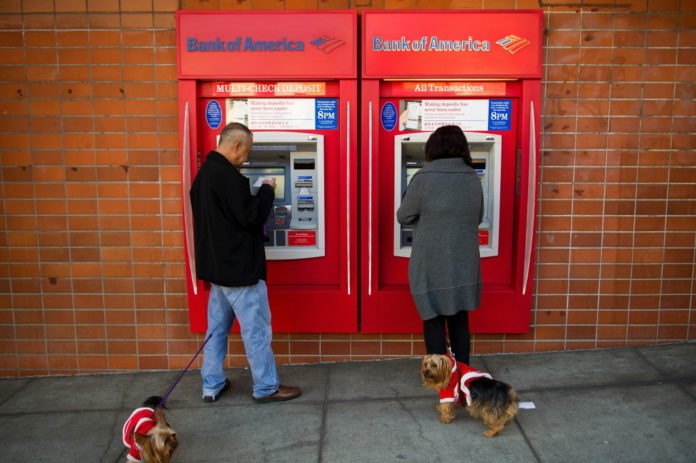
WASHINGTON – Two years after President Barack Obama vowed to eliminate the danger of financial institutions becoming “too big to fail,” the nation’s largest banks are bigger than they were before the nation’s credit markets seized up and required unprecedented bailouts by the government.
Five banks – JPMorgan Chase & Co., Bank of America Corp., Citigroup Inc., Wells Fargo & Co. and Goldman Sachs Group Inc. – held $8.5 trillion in assets at the end of 2011, equal to 56 percent of the U.S. economy, according to central bankers at the Federal Reserve.
Five years earlier, before the financial crisis, the largest banks’ assets amounted to 43 percent of U.S. output. The Big Five today are about twice as large as they were a decade ago relative to the economy, sparking concern that trouble at a major bank would rock the financial system and force the government to step in as it did in 2007 with the Fed-assisted rescue of Bear Stearns Cos. by JPMorgan and in 2008 with Citigroup and Bank of America after the Lehman Brothers bankruptcy, the largest in U.S. history.
“Market participants believe that nothing has changed, that too-big-to-fail is fully intact,” said Gary Stern, former president of the Federal Reserve Bank of Minneapolis.
That specter is eroding faith in Obama’s pledge that taxpayer-funded bailouts are a thing of the past. It is also exposing him to criticism from Federal Reserve officials, Republicans and Occupy Wall Street supporters, who see the concentration of bank power as a threat to economic stability.
As weaker firms collapsed or were acquired, a handful of financial giants emerged from the crisis. Since then, JPMorgan, Goldman Sachs and Wells Fargo have continued to grow internally and through acquisitions from European banks, reeling from government austerity measures related to the rising cost of public debt in Greece, Spain, Portugal, Ireland and Italy.
‘Few Massive Firms’
The industry’s evolution defies the president’s January 2010 call to “prevent the further consolidation of our financial system.” Embracing new limits on banks’ trading operations, Obama said then that taxpayers wouldn’t be well “served by a financial system that comprises just a few massive firms.”
Simon Johnson, a former chief economist of the International Monetary Fund, blames a “lack of leadership at Treasury and the White House” for the failure to fulfill that promise. “It’d be safer to break them up,” he said.
The Obama administration rejects the criticism, citing new safeguards to head off further turmoil in the banking system. Treasury Secretary Timothy Geithner said in a February 2 speech that the U.S. “financial system is significantly stronger than it was before the crisis.” He credits new regulations, including tougher capital and liquidity requirements that limit risk-taking by the biggest banks, authority to take over failing big institutions and prohibitions on the largest banks acquiring competitors.
Angering Taxpayers
The government’s financial system rescue, beginning with the 2008 Troubled Asset Relief Program, angered millions of taxpayers and helped give rise to the Tea Party movement. Banks and bailouts remain unpopular: By a margin of 52 percent to 39 percent, respondents in a February Pew Research Center poll called the bailouts “wrong” and 68 percent said banks have a mostly negative impact on the country.
Banks Cite Changes
The banks say they have increased their capital backstops in response to regulators’ demands, making them better able to ride out unexpected turbulence. JPMorgan, whose chief executive officer, Jamie Dimon, acknowledged public “hostility” toward bankers in a March 30 letter to shareholders, boasted April 13 of a “fortress balance sheet.” Bank of America, which was about 50 percent larger at the end of 2011 than five years earlier, says it has boosted capital and liquidity while increasing to 29 months the amount of time the bank could operate without external funding.
“We’re a much stronger company than we were heading into the crisis,” said Jerry Dubrowski, a Bank of America spokesman. The bank says it plans to shrink by year-end to $1.75 trillion in risk-weighted assets, a measure regulators use to calculate how much capital individual banks must hold.
Still, the banking industry has become increasingly concentrated since the 1980s. Today’s 6,291 commercial banks are less than half the number that existed in 1984, according to the Federal Deposit Insurance Corp. The trend intensified during the crisis as JPMorgan acquired Bear Stearns and Washington Mutual; Bank of America bought Merrill Lynch; and Wells Fargo took over Wachovia in deals encouraged by the government.
“One of the bad outcomes, the adverse outcomes of the crisis, was the mergers that were of necessity undertaken when large banks were at risk,” said Donald Kohn, vice chairman of the Federal Reserve from 2006-2010. “Some of the biggest banks got a lot bigger and the market got more concentrated.”
Concerns Voiced
In recent weeks, at least four current Fed presidents — Esther George of Kansas City, Charles Plosser of Philadelphia, Jeffrey Lacker of Richmond and Richard Fisher of Dallas — have voiced similar worries about the risk of a renewed crisis.
The annual report of the Federal Reserve Bank of Dallas was devoted to an essay by Harvey Rosenblum, head of the bank’s research department, “Why We Must End Too Big to Fail – Now”
A 40-year Fed veteran, Rosenblum wrote in the report released last month: “TBTF institutions were at the center of the financial crisis and the sluggish recovery that followed. If allowed to remain unchecked, these entities will continue posing a clear and present danger to the U.S. economy.”
Dodd-Frank
The alarms come almost two years after Obama signed into law the Dodd-Frank financial-regulation act. The law required the largest banks to draft contingency plans or “living wills” detailing how they would be unwound in a crisis. It also created a financial-stability council headed by the Treasury secretary, charged with monitoring the system for excessive risk-taking.
The new protections represent an effort to avoid a repeat of the crisis and subsequent recession in which almost 9 million workers lost their jobs and the U.S. government committed $245 billion to save the financial system from collapse.
The goal of policy makers is to ensure that if one of the largest financial institutions fails in the next crisis, shareholders and creditors will pay the tab, not taxpayers.
“Two or three years from now, Goldman Sachs should be like MF Global,” said Dennis Kelleher, president of the nonprofit group Better Markets, who doubts the government would allow a company such as Goldman to repeat MF Global Holdings Ltd.’s Oct. 31 collapse.
Dodd-Frank, the most comprehensive rewriting of financial regulation since the 1930s, subjected the largest banks to higher capital requirements and closer scrutiny. The law also barred federal officials from providing specific types of assistance that were used to prevent such firms from failing in 2008. Instead, the Fed will work with the FDIC to put major banks and other large institutions through the equivalent of bankruptcy.
“If a large financial institution should ever fail, this reform gives us the ability to wind it down without endangering the broader economy,” Obama said before signing the act on July 21, 2010. “And there will be new rules to make clear that no firm is somehow protected because it is too big to fail.”
‘Completely Unrealistic’
Officials at the Treasury Department, the Fed and other agencies have spent the past two years drafting detailed regulations to make that vision a reality.
Yet the big banks stayed big or, in some cases, grew larger. JPMorgan, which held $2 trillion in total assets when Dodd-Frank was signed, reached $2.3 trillion by the end of 2011, according to Federal Reserve data.
For Lacker, the banks’ living wills are the key to placing the financial system on sounder footing. Done right, they may require institutions to restructure to make their orderly resolution during a crisis easier to accomplish, he said.
Neil Barofsky, Treasury’s former special inspector general for the Troubled Asset Relief Program, calls the idea of winding down institutions with more than $2 trillion in assets “completely unrealistic.”
It’s likely that more than one bank would face potential failure during any crisis, he said, which would further complicate efforts to gracefully collapse a giant bank. “We’ve made almost no progress on ending too big to fail,” he said.
Bankers’ Responses
Dimon dismisses such concerns as “chatter” and says U.S. banks need heft to meet the needs of their globally active clients. Since 2007, the bank has added more than 80,000 workers, equal to the current combined payrolls of Nike Inc. and Colgate Palmolive Co.
In his annual letter to shareholders, Dimon said JPMorgan will spend almost $3 billion “over the next few years” and devote 3,000 full-time employees to complying with regulations that arose from the crisis.
That regulatory burden could promote further industry consolidation, according to Wilbur Ross, chairman of WL Ross & Co., a private-equity firm.
“We think the little tiny banks, the 90-odd percent of banks that are under $1.5 billion in deposits, are pretty much an obsolete phenomenon,” he told Bloomberg Television on March 14. “We think they’ll all have to merge with each other, be acquired by bigger banks or something.”
Implicit Guarantee
Jake Siewert, a spokesman for Goldman Sachs, and Mary Eshet, a spokeswoman for Wells Fargo, declined to comment. Spokesmen for JPMorgan and Citigroup didn’t respond to e-mailed requests for comment.
Even with policy makers’ claims that the next crisis will be handled differently, investors still regard the largest banks as protected by an implicit government guarantee. One sign of that attitude is that investors continue to demand from the biggest banks lower interest payments in return for deposits.
That gives larger banks a funding advantage over their smaller rivals. In 2011, funding costs for banks with more than $10 billion in assets were about one-third less than for the smallest banks, according to the FDIC. That gap was only slightly narrower than the 37 percent advantage the largest banks enjoyed when Dodd-Frank was signed.
$250 Billion Boost
For 28 global banks in 2009, that benefit translated into a cumulative $250 billion, according to Andrew Haldane, the Bank of England’s executive director for financial stability.
“Markets have come to believe that what the government did in 2008 and 2009 isn’t a one-time deal, that the government will somehow come to the rescue of these big financial firms,” Kevin Warsh, a former member of the Fed’s Board of Governors, said on the March 28 “Charlie Rose” TV show.
Credit-rating companies Standard & Poor’s and Moody’s say they anticipate the U.S. government would rescue large banks in a future crisis. Both cut the major banks’ debt ratings by one level late last year, while retaining them as investment grade credits.
Last month, 15 of the 19 largest U.S. financial institutions passed a Fed “stress test” designed to measure their ability to withstand a deep recession.
Richard Spillenkothen, the Fed’s director of banking supervision and regulation from 1991 to 2006, said regulators are moving in the right direction.
“We’ve made progress. I don’t think we’ve totally resolved it,” said Spillenkothen. “The proof will be in the next crisis.”












